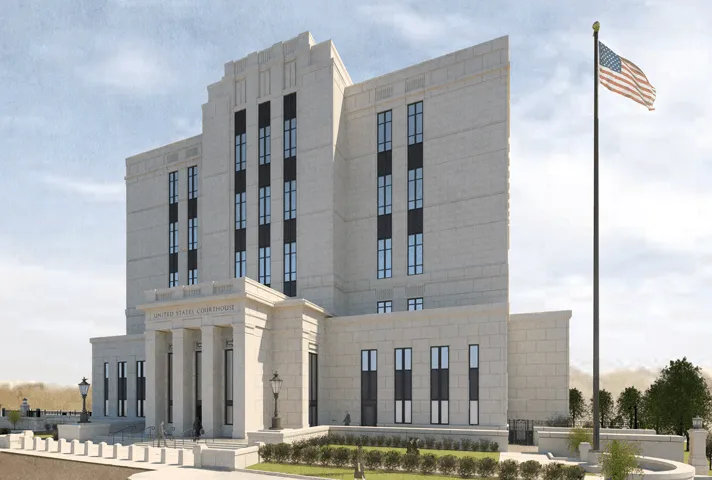Committed to efficiency, safety, and cost containment, the Judiciary responds in a coordinated way to emergencies while also working with the General Services Administration to replace outmoded courthouses with modern, secure facilities.
Pandemic Response
From the start of the COVID-19 crisis in the United States in early 2020, the Judicial Conference recognized the need for a coordinated response among the far-flung court districts and circuits around the country. Most key decisions about court operations and courthouse access were made by judges locally, depending on local public health conditions and city and state government mandates. To facilitate a coordinated response, the Administrative Office of the U.S. Courts (AO) tasked its Facility and Security Office with coordinating systemwide efforts and providing guidance to the courts.
The office provided staff for and coordinated the Judiciary’s COVID-19 Task Force, made up of chief judges and court executives; AO program experts; and representatives from the General Services Administration (GSA), the U.S. Marshals Service, the Federal Protective Service, and the U.S. Attorney’s Office. The task force developed guidance to the courts on a wide range of pandemic-related issues in areas including budgeting, facilities and security, finance and internal control, human resources, information technology, jury duty, and telework. It also published guidelines for courts as they phased in courthouse operations.
The AO coordinated the acquisition and distribution of 1.5 million cotton face masks to Judiciary personnel nationwide. The Judiciary Disaster and Recovery Tool (JDART) was created to collect federal, state, and privately sourced real-time data, including COVID-19 case counts, trends, hospital statistics, and state governor actions. JDART’s reports, geographic analyses, and survey tools provide up-to-date situational awareness to support local Judiciary recovery processes.
Response to Civil Unrest in U.S. Cities
A national crisis followed the tragic death of George Floyd on May 25 in Minneapolis,Minnesota, and several other incidents of African Americans killed by police around the country. Some of the peaceful demonstrations in response to the crisis were infiltrated by violent extremists who disrupted Judiciary operations. David Patrick Underwood, a Federal Protective Service (FPS) security officer, was killed while guarding the Ronald V. Dellums Federal Building and United States Courthouse in Oakland, Calif. More than 55 courthouses were damaged in the protests by year’s end.
AO staff worked with Judge David McKeague, chair of the Judicial Conference Committee on Judicial Security, to increase protection at courthouses with the assistance of officials of the FPS and the U.S. Marshalls Service, including the placement of additional overnight officers in courthouses. In July, these additional forces helped manage a group of extremists that had breached the front door of the Mark O. Hatfield U.S. Courthouse in Portland, Oregon, and caused significant damage. Stepped-up security efforts in several locations remained ongoing at year’s end.
Progress on Courthouse Projects

An artist’s rendering of the new courthouse planned for Greenville, S.C.
The AO managed and supported the courthouse construction projects that were funded by Congress in recent fiscal years. The GSA received approximately $1.4 billion in fiscal year 2016 and 2018, fully funding 11 projects on the Federal Judiciary Courthouse Project Priorities list: in Nashville, Tenn.; Toledo, Ohio; Charlotte, N.C.; Des Moines, Iowa; Greenville, S.C.; Anniston, Ala.; Savannah, Ga.; San Antonio, Texas; Harrisburg, Pa.; Huntsville, Ala.; and Fort Lauderdale, Fla. The GSA also received $53 million to build a new courthouse in Greenville, Miss., and to acquire a courthouse in Rutland, Vt.
The Rutland courthouse has been acquired, and AO staff worked during 2020 with judges, court and circuit staff, and the GSA on executing the remaining projects: Eight were under construction, one was in the phase of finalizing construction documents, three were in the design phase, and one was in the site selection phase. The Nashville, Greenville (S.C.), Savannah Annex, and Charlotte Annex projects were set to finish first, in 2021. While the pandemic delayed the Harrisburg project by at least six months, staff from the AO, the GSA, and the court worked to mitigate other anticipated pandemic-related delays.
Emergency Preparedness
During 2020, the AO assisted with emergency efforts in court districts affected by extreme weather and worked with several courts on their emergency preparedness plans. The plans covered topics such as business and operations continuity, and pandemic response.
In addition, the AO undertook a pilot project called the Judiciary Disaster and Recovery Tool, which collects federal, state, and privately sourced real-time data related to both the COVID-19 pandemic (such as case counts, trends, hospital statistics, and state actions) and natural disasters to provide up-to-date situational awareness and geographical analyses.
During 2020’s heavy hurricane season, the AO’s Judiciary Emergency Response Team (JERT) monitored 29 major storms and other disasters. Of these, four hurricanes and five wildfires disrupted Judiciary operations, prompting the JERT to assist the courts with local response and recovery activities. The JERT facilitated coordination with affected court districts and partner agencies to restore operations, repair facilities, and provide emergency relocation where needed.
Annual Report 2020
- Annual Report 2020
- Court Operations and Pandemic Response
- Funding/Budget
- The Courts and Congress
- The Federal Bench
- Accountability and Resource Management
- Facilities and Security
- Public Outreach
- Defender Services
- Probation and Pretrial Services
- Human Resources
- Information Systems and Cybersecurity
- Recent and Proposed Amendments to Federal Rules
- In Profile



